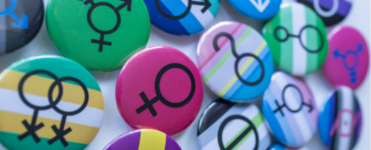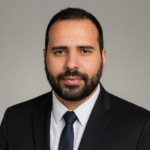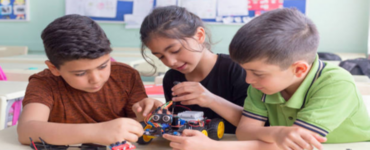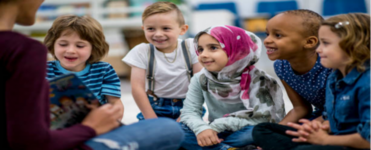Fernando Lesniak
This article highlights the need for gender-just teaching in language education to create classrooms that respect and include all gender identities. It explains how these methods challenge stereotypes, promote equality, and make learning spaces more supportive. Practical strategies and examples are provided to help teachers use gender-inclusive language and foster a sense of belonging for all students.
Keywords: gender-just pedagogies, inclusive language education, gender identity in classrooms, LGBTQ+ inclusivity in education, social justice in teaching, gender-inclusive practices
Introduction
Gender-just pedagogies create inclusive environments by recognizing and respecting all gender identities while actively challenging traditional norms and stereotypes. Inclusivity in language teaching promotes equality, reflects societal progress, and enhances student engagement by making classrooms more welcoming and respectful. This article explores the significance of gender-just pedagogies in education, providing both theoretical insights and practical strategies. Creating such an inclusive learning environment is not only an ethical imperative but also an essential aspect of modern education, reflecting our shared commitment to equity and justice.
The problem
The United States faces a troubling trend of increasing legislative actions targeting gender identity and LGBTQ+ (Lesbian, Gay, Bisexual, Transexual, Queer, and other identities) issues, creating significant challenges for educators and students. For example, in 2022, 137 bills were introduced to limit discussions on race, gender identity, and related topics in classrooms, marking a 250% increase from the previous year (Pendharkar, 2022). By 2023, this number had risen further, with legislation enacted in several states restricting access to gender-affirming care and imposing limitations on the use of preferred pronouns in educational settings (Funakoshi & Raychaudhuri, 2023; Pendharkar, 2023). In 2024, the ACLU was following 533 anti-LGBTQ+ bills. In Minnesota alone, 20 of these bills were introduced, affecting areas such as sports, education, and civil rights. Although all of these bills failed in Minnesota, the political environment we are currently living in might make things different in 2025. These legislative efforts underscore the urgent need for inclusive pedagogies that protect and affirm all students, countering the societal forces that seek to marginalize certain groups (ACLU, 2024).
The rise of restrictive legislation has a chilling effect on classroom dynamics, as educators face heightened scrutiny and potential repercussions for addressing topics related to gender and identity. This creates an environment where students may feel unseen or invalidated, undermining their ability to engage fully in the learning process. Furthermore, these policies perpetuate a culture of fear and exclusion, reinforcing harmful stereotypes and limiting opportunities for critical dialogue. For educators committed to fostering inclusive spaces, navigating these challenges requires both courage and a deep understanding of the principles underpinning gender-just pedagogies.
Defining gender-just pedagogies
Gender-just pedagogies are transformative educational approaches aimed at fostering inclusive learning environments that celebrate and respect all gender identities (Knisely & Paiz, 2021). These pedagogies challenge binary frameworks, traditional norms, and gender stereotypes by embracing the full spectrum of gender identities and advocating for practices that promote equity and social justice. Traditional teaching methods and materials can reinforce gender norms and limit opportunities for students based on their gender identity. Instead, gender-just pedagogies aim to create inclusive learning environments that recognize and celebrate diversity, challenge biases and stereotypes, and empower all students to succeed (Lahelma et al., 2017).
Incorporating gender-inclusive language and practices ensures that students of all genders feel acknowledged, respected, and valued in the classroom. For example, educators can intentionally use nonbinary pronouns in examples, adapt teaching materials to reflect diverse gender identities, and recognize the fluidity of language as it evolves to meet the needs of a changing society (Knisely, 2023).
Central to gender-just pedagogies is the understanding that language is not only a tool for communication but also a powerful medium for identity expression and social change (Knisely, 2022). Traditional educational frameworks often marginalize nonbinary and trans experiences by adhering to rigid linguistic norms that reinforce outdated stereotypes. By challenging prescriptive ideologies, gender-just pedagogies emphasize the dynamic nature of language and its capacity to reflect and support diverse identities (Knisely & Paiz, 2021). This approach invites educators and students to critically engage with language as a system that can either perpetuate inequities or serve as a vehicle for empowerment and inclusion.
Implementing gender-just pedagogies involve more than superficial inclusivity; it requires a commitment to creating spaces where all students can thrive academically and personally. This includes addressing resistance, which may arise from normative or transphobic viewpoints. Educators can adopt trans-affirming queer inquiry-based pedagogies (TAQIBPs) to navigate such challenges effectively. TAQIBPs emphasize reflexivity, contextual understanding, and proactive planning to ensure that inclusivity efforts are both meaningful and sustainable (Knisely & Paiz, 2021). This structured approach promotes critical self-reflection among educators, enabling them to tailor their responses to resistance while maintaining a focus on advancing social justice.
The importance of inclusivity in language teaching
Inclusivity in language teaching is critical for fostering respect, equality, and a sense of belonging among students. When educators use inclusive language, they affirm diverse identities, contributing to a supportive and positive learning atmosphere. Moreover, language teaching that reflects societal changes prepares students for a world where inclusivity and diversity are core values. Research highlights how inclusive practices not only promote engagement but also lead to better educational outcomes, as students feel safer and more empowered to participate actively in their learning (Knisely, 2022). This approach reflects the evolving understanding of gender in broader society and challenges educators to rethink traditional methodologies in favor of more equitable practices.
Language classrooms are uniquely positioned to be sites of transformation. By incorporating gender-inclusive practices, educators can model the values of respect and empathy, equipping students with the skills to navigate diverse social contexts. Additionally, inclusive teaching fosters critical thinking, as students are encouraged to interrogate how language both reflects and perpetuates power dynamics. This dual focus on linguistic competence and social awareness ensures that language education remains relevant and impactful in a rapidly changing world.
The benefits of inclusive language education
Inclusive language education offers numerous benefits that extend beyond the classroom, shaping both individual and societal outcomes. By acknowledging and respecting diverse identities, inclusive language promotes equity and fosters a welcoming environment where students feel valued and supported. This sense of belonging bolsters self-esteem and encourages active participation, creating a classroom culture that reflects and respects the identities of all students. When students see themselves represented in materials and practices, their engagement deepens, and a stronger sense of community emerges.
Furthermore, inclusive language aligns education with broader social changes by preparing students to navigate and contribute to an increasingly diverse world. It reinforces the idea that language is not just a means of communication but also a reflection of societal values and progress. Through critical analysis of language use, students gain insight into how words shape and reflect power dynamics, encouraging them to think critically about inclusivity and representation. These practices not only enhance individual understanding but also contribute to a cultural shift toward acceptance and understanding, positioning education as a powerful catalyst for social progress.
Practical strategies for implementing gender-inclusive language (GIL)
Start with education and discussion
The foundation for gender-inclusive practices in education begins with open and intentional conversations about diversity, equity, and inclusion (DEI). By connecting the concept of GIL to broader DEI goals, educators can create a classroom environment that encourages reflection and fosters understanding. Such discussions highlight the role language plays in shaping inclusive spaces and inspire students to think critically about the power of words.
Strategy in Action: Begin the semester with a dialogue focused on the evolution of gender-inclusive language across cultures. This activity not only sets the tone for an inclusive classroom but also allows students to explore historical and cultural perspectives on gendered language. For example, you might delve into the introduction and normalization of gender-neutral pronouns in English, such as “they/them,” examining their origins, applications, and cultural significance. Students can share their thoughts, ask questions, and discuss how linguistic shifts reflect societal changes.
Create a supportive environment
A supportive classroom culture is essential for encouraging students to explore and embrace GIL. Allowing students to share their preferred pronouns and affirming their choices builds trust and respect.
Strategy in Action: On the first day of class, invite students to introduce themselves and share their pronouns, either verbally or through written submissions. Emphasize that pronouns can be updated at any time and provide opportunities for students to express changes as the semester progresses. Create an open dialogue where students feel safe to discuss their experiences with language and identity.
Normalize gender-inclusive language
To normalize GIL, educators should model it consistently in lectures, discussions, and materials. Integrating gender-neutral terms across all aspects of teaching demonstrates that inclusivity is not just an occasional consideration but a standard practice. This includes using inclusive examples, rephrasing traditional gendered expressions, and emphasizing the use of neutral terms in student work.
Strategy in Action: When introducing vocabulary for professions, replace terms like “fireman” and “policeman” with “firefighter” and “police officer.” Incorporate these examples into exercises, quizzes, and classroom discussions. To deepen engagement, prompt students to brainstorm other professions with historically gendered language and suggest neutral alternatives.
Provide clear guidelines and resources
Students often feel more confident using GIL when they have access to clear guidelines and practical tools. By providing a comprehensive resource guide, educators can equip learners with the knowledge they need to implement inclusive practices effectively.
Strategy in Action: Develop a digital toolkit that includes a glossary of nonbinary pronouns, examples of inclusive grammar rules, and cultural notes on GIL in various contexts. Complement this resource with in-class workshops or tutorials that demonstrate how to incorporate these principles into writing, speaking, and peer interactions.
Incorporate GIL across proficiency levels
Building familiarity with GIL requires a systematic approach across different proficiency levels. Start with foundational concepts in beginner courses and gradually introduce more complex applications in advanced classes. This scaffolded approach ensures students develop a nuanced understanding of inclusivity over time.
Strategy in Action: Design a curriculum that introduces basic GIL principles in early coursework—for example, through simple sentence construction exercises that use nonbinary pronouns. In intermediate levels, expand to discussions on how language influences social dynamics. In advanced courses, challenge students to analyze case studies or engage in debates about the role of GIL in media and politics.
Stay informed and adaptive
Language is constantly evolving, and staying informed about developments in GIL ensures that teaching practices remain relevant. Educators should incorporate ongoing research and current debates into their lessons to keep the material fresh and engaging.
Strategy in Action: Introduce discussions on recent advancements, such as the adoption of “Mx.” as a gender-neutral title in professional settings. Encourage students to research and present on emerging trends in GIL, fostering an environment of shared learning and discovery.
Foster cultural context awareness
Understanding the cultural and regional variations of GIL enriches the learning experience and broadens students’ perspectives. Discussing these differences helps students recognize that inclusivity is shaped by social and cultural contexts.
Strategy in Action: Examine gender-inclusive practices in various English-speaking countries. For instance, highlight Canada’s emphasis on inclusive language policies in schools and workplaces, contrasting it with practices in the United States or the United Kingdom. This activity can include student-led presentations or group discussions, allowing for diverse insights.
Promote active engagement
Active participation ensures that students internalize the principles of GIL and can apply them confidently. Encourage collaborative projects, peer discussions, and reflective writing assignments centered on inclusivity.
Strategy in Action: Assign a group project where students analyze media representations of gender-inclusive language in different cultures. Teams can explore how language is used in advertisements, news articles, or entertainment to promote or hinder inclusivity. This analysis not only deepens understanding but also sharpens critical thinking skills.
Offer guidance and feedback
Constructive feedback is crucial for helping students refine their use of GIL. By providing clear, supportive comments, educators can guide students toward greater linguistic and cultural awareness.
Strategy in Action: When reviewing essays or presentations, note instances where gender-inclusive language could be improved. For example, suggest using “folks” or “everyone” instead of “guys” to address groups. Pair feedback with positive reinforcement to encourage continued progress.
Commit to continual improvement
Regularly updating teaching materials and practices ensures alignment with the latest best practices in GIL. Collaboration among educators can also drive innovation and support professional growth.
Strategy in Action: Host periodic workshops on inclusive teaching strategies, inviting colleagues to share experiences and insights. Collaborate on creating new activities, such as role-playing scenarios that highlight the impact of gendered language. Staying committed to growth not only benefits students but also reinforces the educator’s role as a champion for inclusivity.
Addressing challenges and cultural variations in gender-inclusive language
As educators move toward implementing gender-just pedagogies, it is essential to consider not only the benefits of inclusive practices but also the complexities and cultural tensions they may evoke in diverse learning environments. While inclusive language supports equity and belonging, its adoption across languages and communities often presents some challenges that educators must navigate with care and reflexivity.
Cultural and linguistic considerations
Gendered language systems vary widely across linguistic and cultural contexts, and these differences impact how GIL can be meaningfully introduced. For instance, in Mandarin Chinese, the spoken third-person pronoun tā is gender-neutral. However, written distinctions—他 (he), 她 (she), and 它 (it)—introduce gender in ways that reflect relatively recent sociopolitical ideologies rather than inherent linguistic necessity (Reilly-Thornton, 2021). This example underscores how even languages with seemingly inclusive features may carry gendered implications in their orthography or usage.
Languages like Spanish, which heavily rely on grammatical gender, pose additional challenges. Research shows that nonbinary speakers and educators are actively reimagining Spanish through linguistic innovations such as the morphemes -e and -x (e.g., amigue, amigx [friend]) to break from binary norms (Barnes, 2024; Papadopoulos, 2024). These emergent forms, however, are not universally accepted. They often generate confusion or resistance among speakers unfamiliar with or uncomfortable using non-normative grammar, particularly in oral cultures or among learners new to academic Spanish.
Teachers should approach these differences not as obstacles to avoid but as opportunities for critical inquiry into how language both reflects and shapes cultural values. Facilitating comparative linguistic discussions can foster global awareness while helping students reflect on the evolving role of gender in their own language practices.
Recognizing and navigating resistance
In many educational settings, the introduction of gender-inclusive language may be met with hesitation or resistance, not necessarily due to intolerance, but because of cultural norms, generational beliefs, or unfamiliarity. Even well-meaning students and families may struggle with new linguistic forms such as Latinx, which has been criticized for not aligning with Spanish phonology and for alienating some speakers. Scholars have suggested alternatives like Latine, which offer a more phonetically intuitive and culturally accessible option (Bernardo-Hinesley & Arias Álvarez, 2022; Robertson, 2024).
It is crucial for educators to recognize these challenges and respond with empathy and flexibility. Gender-inclusive pedagogy is not about enforcing a singular way of speaking; it is about expanding possibilities and fostering respectful dialogue. Teachers should create space for student reflection, validate concerns, and model inclusive practices without imposing rigid expectations. Framing inclusive language as part of broader intercultural communicative competence can help ground these conversations in curiosity rather than compliance.
Political sensitivity and pedagogical caution
Finally, given the current sociopolitical climate, implementing gender-just practices requires strategic awareness. In many regions, discussing topics related to gender identity and inclusive language in classrooms can draw scrutiny from administrators, community members, or policymakers. As recent legislative trends have shown, teachers working toward inclusivity may find themselves navigating institutional or even legal barriers (ACLU, 2024; Pendharkar, 2023).
This reality does not mean that educators should avoid these conversations. Rather, it calls for tactful, transparent, and informed engagement. Knisely (2023) urges language educators to frame inclusive language as part of real-world communicative competence and cultural literacy (essential components of language education), not ideological impositions. Presenting inclusive forms as examples of contemporary language variation, rather than mandates, can help mitigate conflict while maintaining a commitment to equity.
By acknowledging these cultural, political, and linguistic dynamics, educators can create more intentional and adaptive approaches to GIL implementation. This critical awareness lays the foundation for fostering inclusive classrooms through gender-just language practices.
Conclusion
Creating inclusive and respectful learning environments is essential for advancing equity and justice in education. By integrating gender-just pedagogies, educators can challenge traditional norms, promote dynamic language practices, and empower students to engage with the world as thoughtful, inclusive communicators. The journey toward inclusivity is ongoing, but the benefits for students and society are immeasurable.
Gender-just pedagogies represent a call to action for educators to reimagine their roles as facilitators of social change. By prioritizing inclusivity, educators not only enhance the learning experience but also contribute to a more equitable and compassionate world. This commitment to justice and diversity is the foundation of transformative education, inspiring students to envision and create a future where all identities are celebrated and respected.
At the same time, implementing these pedagogies requires a thoughtful and nuanced approach. Educators must navigate linguistic diversity, cultural resistance, and political tensions with care, empathy, and strategic awareness. Recognizing that language is situated, evolving, and deeply connected to identity empowers teachers to meet students where they are, while still pushing the boundaries of what is possible in the classroom. Inclusive language is not about enforcing uniformity, it is about expanding possibilities for expression, belonging, and mutual respect. By embracing this complexity, educators affirm their role as not just language instructors, but as builders of more just and inclusive communities.
References
American Civil Liberties Union (ACLU). (2024, December 6). Mapping attacks on LGBTQ rights in U.S. state legislatures in 2024. https://www.aclu.org/legislative-attacks-on-lgbtq-rights-2024
Barnes, M. (2024). ‘Estamos pavimentando el camino para futuros hablantes del castellano’: Nonbinary Peninsular Spanish languaging as prefigurative politics. In K. A. Knisely & E. L. Russell (Eds.), Redoing linguistic worlds: Unmaking gender binaries, remaking gender pluralities (pp. 175–195). Multilingual Matters. https://doi.org/10.2307/jj.22679690.16
Bernardo-Hinesley, S., & Álvarez, A. A. (2024). Remaking Spanish gender binaries: Online attitudes toward gender pluralities. In K. A. Knisely & E. L. Russell (Eds.), Redoing linguistic worlds: Unmaking gender binaries, remaking gender pluralities (pp. 153–172). Multilingual Matters. https://doi.org/10.2307/jj.22679690.15
Funakoshi, M., & Raychaudhuri, D. (2023, August 19). The rise of anti-trans bills in the US. Reuters. https://www.reuters.com/graphics/USA-HEALTHCARE/TRANS-BILLS/zgvorreyapd/
Knisely, K.A. (2022). Planning for gender justice:The gender-just education project. Retrieved March 1, 2023, from https://www.krisknisely.com/plan-for-justice
Knisely, K.A. (2023). Gender‐justice beyond inclusion: How trans knowledges and linguistic practices can and should be re‐shaping language education. The Modern Language Journal, 107(2), 607–623. https://doi.org/10.1111/modl.12871
Knisely, K. & Paiz, J.M. (2021) Bringing trans, non-binary, and queer understandings to bear in language education. Critical Multilingualism Studies, 9(1), 23-45. https://cms.arizona.edu/index.php/multilingual/article/view/237
Lahelma, E., Teräs, M., & Lappalainen, S. (2017). Gender-just pedagogies in early childhood education: A systematic literature review. Journal of Early Childhood Education Research, 6(1), 1-24. https://doi.org/10.2991/assehr.k.210322.070
Papadopoulos, B. (2024). Identifying gender in gendered languages: The case of Spanish. In K. Knisely & E. Russell (Eds.), Redoing linguistic worlds: Unmaking gender binaries, remaking gender pluralities (pp. 196-217). Multilingual Matters. https://doi-org.ezp3.lib.umn.edu/10.21832/9781800415102-015
Pendharkar, E. (2022, August 18). Bills targeting classroom talk on race and gender identity ballooned this year. Education Week. https://www.edweek.org/leadership/bills-targeting-classroom-talk-on-race-and-gender-identity-ballooned-this-year/2022/08
Pendharkar, E. (2023, June 14). Pronouns for trans, nonbinary students: The states with laws that restrict them in schools. Education Week. https://www.edweek.org/leadership/pronouns-for-trans-nonbinary-students-the-states-with-laws-that-restrict-them-in-schools/2023/06
Reilly-Thornton, A. (2021). Gendered pronouns in Chinese EL2 speech: The case of epicene pronouns. TEANGA, The Journal of the Irish Association for Applied Linguistics, 28, 247-277. https://doi.org/10.35903/teanga.v28i.697
Robertson, M. (2024). Breaking rules of guided language. In M. Marzullo & W.L. Leap (Eds.), Critical sexuality studies, lavender languages, and everyday life (pp. 92–118). Bloomsbury Academic. http://dx.doi.org/10.5040/9781350359987.0012











